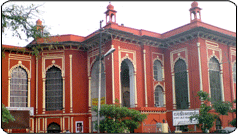Lal Baradari
Today the Baradari of Qaiser Bagh, also known as the Safed Baradari because of its colour (safed that is white), is a place of celebration and gaeity where the elite of the city solemnise marriages and hold receptions. Perhaps it would be a shock for the people who have been to such occasions of joy to learn that initially the building was meant as 'palace of mourning' and was named Qasr-ul-Aza as such. It was built by the last King of Awadh, Wajid Ali Shah as an Imambara for observing azadaari (mourning) for the martyrdom of Imam Hussain and his followers at Karbala.
Professor Masood Hussain Rizvi in his book on Wajid Ali Shah has reproduced a chronogram by Maqbool-ud-Daulah Mehdi Ali Khan, who composed under the takhallus (pen-name) of Qabool which provides the year of inception of the palace of mourning Qasr-ul-Aza as 1270 Hijri (1854) by the Sultan, Wajid Ali Shah.
Prof. Rizvi has stated in the book that he had himself seen a book on Lucknow (in English) at the Amir-ud-Daulah Public Library wherein a photograph showed the interior of the Imambara with a taazia and alams (banners) and a zakir (preacher) appeared seated on a mimbar (pulpit) for addressing a majlis (assembly for mourning).
He has also cited the account of a contemporary historian of the period of Wajid Ali Shah, Kamal-ud-din Haider, who in Qaiser-ut-Tawareekh (vol. 2) speaks of one Syed Mehdi Hasan having returned from a pilgrimage to Karbala, with a zarih (replica of the tomb of Imam Hussain) made from Khaak-e-shlfa (sacred earth from the place of Imam Hussain's martyrdom) that is believed to have a curative property. The zarih was initially placed at Karbala of Dayanat-ud-Daulah on 26th of Shaban 1270 Hijri (May 1854). The King, Wajid Ali Shah also came to learn of it and donning black garments proceeded to pay respects to it at Kazmain, along with his nobles who were also dressed in black, the colour of mourning. Thereafter, he ordered that the zarih be taken out in a royal procession, and placed in his newly built Imambara Qasr-ul-Aza at Qaiser Bagh. The King also rewarded Syed Mehdi Hasan with cash and conferred upon him a khillat (robe of honour).
After the annexation of Awadh in 1856, the Baradari was used by the British to hold court for petitions and claims by the officers and nobles of the deposed King's reign and his relatives. Later [around 1923 or later] it was handed over, as a gesture of appreciation for their submission and loyalty to the Queen of the British Empire, to the Taluqadars of Awadh for their Anjuman which was renamed as the British India Association of Oudh. The Baradari continues to be in their possession and control. The main hall of the Baradari has two marble statues of the Maharajas, Man Singh and Digvijai Singh of Balrampur, the founders of the association.
Source:
Hindustan Times, City Scan, A Time in History
Wednesday 29.4.1998 — Palace of mourning

